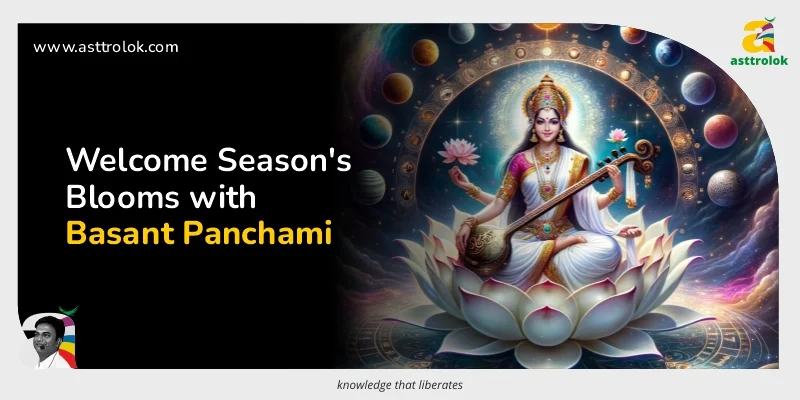
Introduction:
Basant Panchami, also known as Vasant Panchami, marks the arrival of spring, a season synonymous with renewal, rejuvenation, and the promise of new beginnings. Celebrated with great enthusiasm across India, Basant Panchami heralds the end of winter's chill and the onset of warmer days filled with the vibrant colors of blooming flowers and the sweet melodies of birdsong. In this blog, we embark on a journey to explore the significance, traditions, and festivities associated with Basant Panchami, as we welcome the season of blooms and blossoms with open arms.
Get an online astrology consultation by the world-renowned astrologer Mr. Alok Khandelwal.
Significance of Basant Panchami:
Basant Panchami falls on the fifth day (Panchami) of the bright half (Shukla Paksha) of the Hindu lunar month of Magha, typically occurring in late January or early February. The word Basant translates to spring, and the festival symbolizes the triumph of light over darkness, warmth over cold, and life over death. It is a time of joyous celebration as nature awakens from its wintry slumber, adorning the landscape with vibrant hues of yellow, the color associated with Basant Panchami.
Honoring Goddess Saraswati:
One of the central themes of Basant Panchami is the worship of Goddess Saraswati, the embodiment of wisdom, knowledge, arts, and learning. Saraswati is revered as the divine source of creativity and inspiration, and her blessings are sought by students, artists, musicians, and scholars. Devotees adorn her with yellow attire and offer prayers, seeking her blessings for success and enlightenment in their academic and creative pursuits.
Basant Panchami Traditions and Customs:
1. Wearing Yellow Attire:
Yellow holds great significance during Basant Panchami, symbolizing the vibrancy of spring and the blossoming of life. People traditionally wear yellow clothing and accessories on this day to pay homage to the season's radiant beauty and to invoke prosperity and happiness.
2. Saraswati Puja:
Saraswati Puja is the focal point of Basant Panchami celebrations, with devotees setting up elaborate altars adorned with flowers, fruits, incense, and images of Goddess Saraswati. Special prayers and hymns are offered to the goddess, followed by the ritualistic worship (puja) and the chanting of mantras to invoke her blessings.
3. Offering Basant (Yellow) Flowers:
Basant Panchami is incomplete without the offering of yellow flowers, particularly marigolds, to Goddess Saraswati. Flowers are considered sacred in Hindu culture and are believed to symbolize purity, devotion, and auspiciousness.
4. Flying Kites:
In many parts of India, especially in North India, flying kites is a popular tradition associated with Basant Panchami. The skies come alive with colorful kites of all shapes and sizes, symbolizing the victory of light over darkness and the triumph of good over evil.
Read Also : Ganesha's Grace: Sankashti Chaturthi - South India's Sacred Celebration
Basant Panchami Festivities Across India:
1. West Bengal:
In West Bengal, Basant Panchami is celebrated as "Saraswati Puja," with schools, colleges, and educational institutions organizing special prayers and ceremonies in honor of the goddess. Students offer their textbooks and instruments at the feet of Saraswati, seeking her blessings for academic success.
2. Punjab:
Basant Panchami holds special significance in Punjab, where it is celebrated as Basant Festival. People gather in open fields and rooftops to fly kites and engage in friendly kite-flying competitions. The skies of Punjab are filled with colorful kites, and the atmosphere resonates with joy and laughter.
3. Rajasthan:
In Rajasthan, Basant Panchami is celebrated with great pomp and splendor, with people dressing in yellow attire and adorning their homes with marigold flowers. The day is marked by lively processions, traditional folk music and dance performances, and the worship of Goddess Saraswati.
Conclusion:
Basant Panchami is a joyous occasion that celebrates the arrival of spring and the awakening of nature from its wintry slumber. It is a time of renewal, growth, and optimism, as people bid farewell to the cold and darkness of winter and embrace the warmth and vibrancy of spring. As we welcome the season of blooms and blossoms with open hearts and joyful spirits, let us seek inspiration from Goddess Saraswati and embark on a journey of learning, creativity, and self-discovery. May Basant Panchami bring abundance, prosperity, and happiness to all!
Read also : Why Vedic Astrology is Important in Kaliyug?
Comments (0)
Categories
Recent posts


जन्मकुंडली में ...
30 Aug 2023
Importance of Bhakoot Koota in Kundali ...
30 Aug 2023

.webp)














